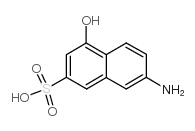134-47-4
| Name | 7,7'-(Carbonylbis(azanediyl))bis(4-hydroxynaphthalene-2-sulfonic acid) |
|---|---|
| Synonyms |
6,6'-Ureylene-bis(1-naphthol-3-sulfonic acid)
EINECS 205-142-9 |
| Description | AMI-1 free acid is a potent, cell-permeable and reversible inhibitor of protein arginine N-methyltransferases (PRMTs), with IC50s of 8.8 μM and 3.0 μM for human PRMT1 and yeast-Hmt1p, respectively. AMI-1 free acid exerts PRMTs inhibitory effects by blocking peptide-substrate binding[1]. |
|---|---|
| Related Catalog | |
| Target |
IC50: 8.8 μM (PRMT1), 3.0 μM (yeast-Hmt1p)[1] |
| In Vitro | AMI-1 free acid can inhibit the in vitro methylation reactions performed by all five recombinantly active PRMTs (PRMT1, -3, -4, and -6 and Hmt1p)[2]. AMI-1 free acid not only inhibits type I PRMTs (PRMT1, 3, 4 and 6) but also type II PRMT5[2]. AMI-1 free acid specifically inhibits arginine, but not lysine, methyltransferase activity in vitro and does not compete for the AdoMet binding site[3]. AMI-1 free acid inhibits methylation of GFP-Npl3 and cellular proteins[3]. AMI-1 free acid (0.6-2.4 mM; 48-96 hours) inhibits the cell viability of sarcoma in S180 and U2OS cells in a time-dependent and dose-dependent manner in vitro[4]. AMI-1 free acid (1.2-2.4 mM; 48-72 hours) reduces S180 cell viability through the induction of cell apoptosis[4]. Cell Viability Assay[4] Cell Line: S180 cells, U2OS cells Concentration: 0.6 mM, 1.2 mM, 2.4 mM Incubation Time: 48 hours, 72 hours, 96 hours Result: Inhibited the cell viability. Apoptosis Analysis[4] Cell Line: S180 cells Concentration: 1.2 mM, 2.4 mM Incubation Time: 48 hours, 72 hours Result: Increased the percentages of cells undergoing apoptosis. |
| In Vivo | AMI-1 free acid (0.5 mg; intratumorally; daily; for 7 days) inhibits S180 viability in vivo[4]. AMI-1 free acid (0.5 mg; intratumorally; daily; for 7 days) downregulates PRMT5 but does not regulate the expression of PRMT7 in a tumor xenograft model[4]. AMI-1 free acid (0.5 mg; intratumorally; daily; for 7 days) decreases the levels of H4R3me2s and H3R8me2s in a tumor xenograft model[4]. Animal Model: 6-7 weeks old male Kunming mice (18-22 g), with S180 cells xenograft[4] Dosage: 0.5 mg Administration: Intratumorally, daily, for 7 days Result: Decreased tumor weight. |
| References |
| Density | 1.798 g/cm3 |
|---|---|
| Melting Point | 86-88 °C |
| Molecular Formula | C21H16N2O9S2 |
| Molecular Weight | 504.49000 |
| Exact Mass | 504.03000 |
| PSA | 207.09000 |
| LogP | 5.84920 |
| Index of Refraction | -45 ° (C=1, AcOH) |
|
Material Safety Data Sheet
Section1. Identification of the substance Product Name: 6,6’-Ureylene-bis(1-naphthol-3-sulfonic acid) Synonyms: Section2. Hazards identification Harmful by inhalation, in contact with skin, and if swallowed. Section3. Composition/information on ingredients. Ingredient name:6,6’-Ureylene-bis(1-naphthol-3-sulfonic acid) CAS number:134-47-4 Section4. First aid measures Skin contact:Immediately wash skin with copious amounts of water for at least 15 minutes while removing contaminated clothing and shoes. If irritation persists, seek medical attention. Eye contact:Immediately wash skin with copious amounts of water for at least 15 minutes. Assure adequate flushing of the eyes by separating the eyelids with fingers. If irritation persists, seek medical attention. Inhalation:Remove to fresh air. In severe cases or if symptoms persist, seek medical attention. Ingestion:Wash out mouth with copious amounts of water for at least 15 minutes. Seek medical attention. Section5. Fire fighting measures In the event of a fire involving this material, alone or in combination with other materials, use dry powder or carbon dioxide extinguishers. Protective clothing and self-contained breathing apparatus should be worn. Section6. Accidental release measures Personal precautions: Wear suitable personal protective equipment which performs satisfactorily and meets local/state/national standards. Respiratory precaution:Wear approved mask/respirator Hand precaution:Wear suitable gloves/gauntlets Skin protection:Wear suitable protective clothing Eye protection:Wear suitable eye protection Methods for cleaning up: Mix with sand or similar inert absorbent material, sweep up and keep in a tightly closed container for disposal. See section 12. Environmental precautions: Do not allow material to enter drains or water courses. Section7. Handling and storage Handling:This product should be handled only by, or under the close supervision of, those properly qualified in the handling and use of potentially hazardous chemicals, who should take into account the fire, health and chemical hazard data given on this sheet. Store in closed vessels. Storage: Section8. Exposure Controls / Personal protection Engineering Controls: Use only in a chemical fume hood. Personal protective equipment: Wear laboratory clothing, chemical-resistant gloves and safety goggles. General hydiene measures: Wash thoroughly after handling. Wash contaminated clothing before reuse. Section9. Physical and chemical properties Appearance:Not specified Boiling point:No data No data Melting point: Flash point:No data Density:No data Molecular formula:C21H16N2O9S2 Molecular weight:504.5 Section10. Stability and reactivity Conditions to avoid: Heat, flames and sparks. Materials to avoid: Oxidizing agents. Possible hazardous combustion products: Carbon monoxide, nitrogen oxides, sulfur oxides. Section11. Toxicological information No data. Section12. Ecological information No data. Section13. Disposal consideration Arrange disposal as special waste, by licensed disposal company, in consultation with local waste disposal authority, in accordance with national and regional regulations. Section14. Transportation information Non-harzardous for air and ground transportation. Section15. Regulatory information No chemicals in this material are subject to the reporting requirements of SARA Title III, Section 302, or have known CAS numbers that exceed the threshold reporting levels established by SARA Title III, Section 313. SECTION 16 - ADDITIONAL INFORMATION N/A |
| Hazard Codes | Xi |
|---|---|
| Safety Phrases | S22-S24/25 |
| WGK Germany | 3 |
| HS Code | 2922210000 |
|
~90% 
134-47-4 |
| Literature: Ragno, Rino; Simeoni, Silvia; Castellano, Sabrina; Vicidomini, Caterina; Mai, Antonello; Caroli, Antonella; Tramontano, Anna; Bonaccini, Claudia; Trojer, Patrick; Bauer, Ingo; Brosch, Gerald; Sbardella, Gianluca Journal of Medicinal Chemistry, 2007 , vol. 50, # 6 p. 1241 - 1253 |
|
~% 
134-47-4 |
| Literature: DE116200 ; |
| Precursor 3 | |
|---|---|
| DownStream 0 | |
| HS Code | 2934999090 |
|---|---|
| Summary | 2934999090. other heterocyclic compounds. VAT:17.0%. Tax rebate rate:13.0%. . MFN tariff:6.5%. General tariff:20.0% |




